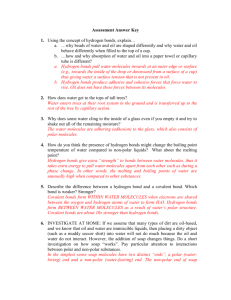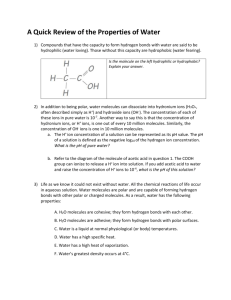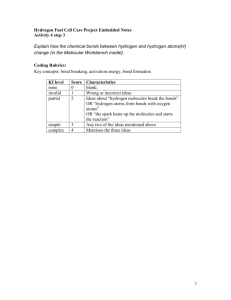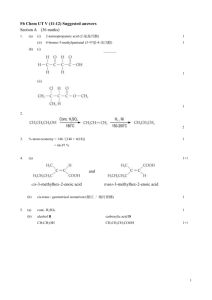3.1 Chemistry of life
advertisement
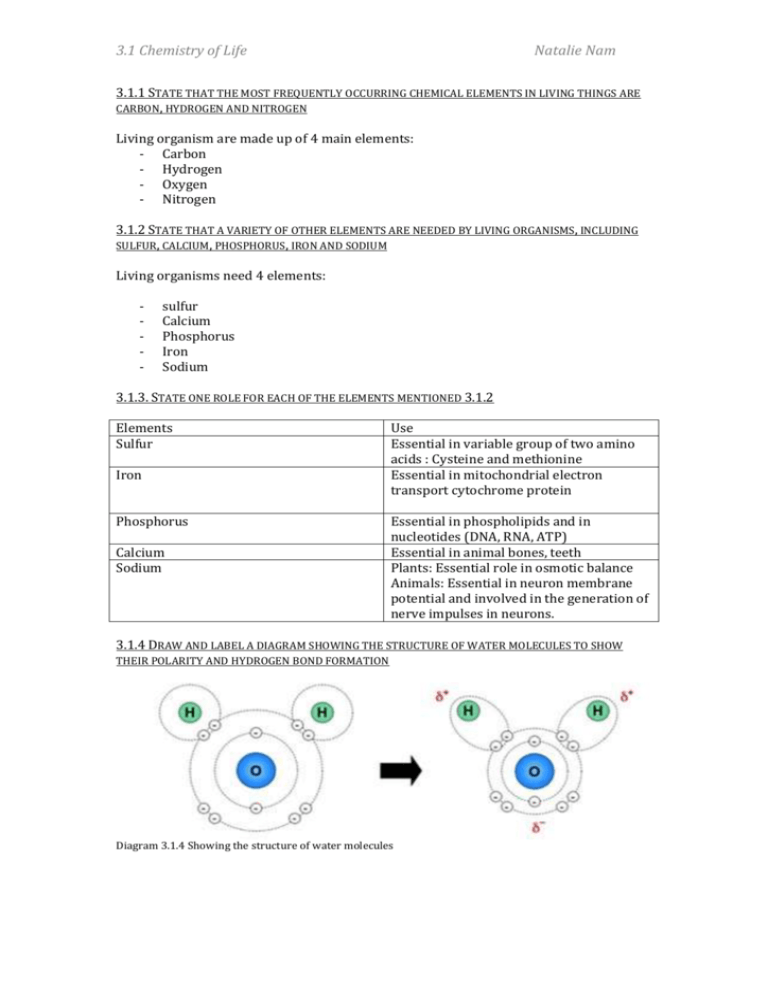
3.1 Chemistry of Life Natalie Nam 3.1.1 STATE THAT THE MOST FREQUENTLY OCCURRING CHEMICAL ELEMENTS IN LIVING THINGS ARE CARBON, HYDROGEN AND NITROGEN Living organism are made up of 4 main elements: - Carbon - Hydrogen - Oxygen - Nitrogen 3.1.2 STATE THAT A VARIETY OF OTHER ELEMENTS ARE NEEDED BY LIVING ORGANISMS, INCLUDING SULFUR, CALCIUM, PHOSPHORUS, IRON AND SODIUM Living organisms need 4 elements: - sulfur Calcium Phosphorus Iron Sodium 3.1.3. STATE ONE ROLE FOR EACH OF THE ELEMENTS MENTIONED 3.1.2 Elements Sulfur Iron Phosphorus Calcium Sodium Use Essential in variable group of two amino acids : Cysteine and methionine Essential in mitochondrial electron transport cytochrome protein Essential in phospholipids and in nucleotides (DNA, RNA, ATP) Essential in animal bones, teeth Plants: Essential role in osmotic balance Animals: Essential in neuron membrane potential and involved in the generation of nerve impulses in neurons. 3.1.4 DRAW AND LABEL A DIAGRAM SHOWING THE STRUCTURE OF WATER MOLECULES TO SHOW THEIR POLARITY AND HYDROGEN BOND FORMATION Diagram 3.1.4 Showing the structure of water molecules 3.1 Chemistry of Life Natalie Nam Structure of water molecule: - Made up of two H2 atoms and a single O2 atom held together by a polar covalent bond. Polar Covalent bond: - Electrons are not shared equally O2 has more protons hence will attract electrons more strongly. Therefore, the O2 atoms will be more negative (δ-) and H2 more positive (δ+). Diagram 3.1.4 Showing hydrogen bond formation Hydrogen Bond formation - Since Oxygen atom is (δ+) and Hydrogen atoms are (δ+), these opposite charges attract each other hence forming hydrogen bonds. - These hydrogen bonds are weak and can be easily broken. 3.1.5 OUTLINE THE THERMAL, COHESIVE AND SOLVENT PROPERTIES OF WATER Thermal Hydrogen bonds between the polar water molecules cause water to resist changes: - High Specific heat – a high enery needed to change water temperature by one degree celcius - High heat of fusion – a high amount of energy will be lost to freeze water Cohesive Water molecules ‘stick together’ due to hydrogen bonds so water has a high cohesion Solvent - The polarity of water attracts or dissolve any other polar or charged particle 3.1.6 EXPLAIN THE RELATIONSHIP BETWEEN THE PROPERTIES OF WATER AND ITS USES IN LIVING ORGANISMS AS A COOLANT, MEDIUM FOR METABOLIC REACTIONS AND TRANSPORT MEDIUM Coolant Metabolic Reactions 3.1 Chemistry of Life Natalie Nam Water is a polar medium where other polar or charged molecules can dissolve in Transport Hydrogen bonds between water molecules allow them to be cohesive. Therefore water is able to by pulled up in xylem vessels.






